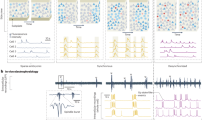Abstract
In PNS and CNS remarkable rearrangements occur soon after the connections are laid down in the course of embryonic life. These processes clearly follow the period of developmental cell death and mostly take place during the very beginning of postnatal life. They consist in changes of the peripheral fields of neurons, marked by elimination of many inputs, while others undergo further maturation and strengthening. Along the efforts to uncover the signals that regulate development, it turned out that while the initial construction of the circuits is heavily based on chemical cues, the subsequent rearrangement is markedly influence by activity. Here we describe experiments testing the influence on developmental plasticity of a particular aspect of activity, the timing of nerve impulses in the competing inputs. Two recent investigations are reviewed, indicating strikingly similar developmental features in quite different systems, neuromuscular and visual. A sharp contrast between the effects of synchrony and asynchrony emerges, indicating that Hebb-related activity rules are important not only for learning but also for development.


Similar content being viewed by others
References
Bliss TV, Lomo T (1973) Long-lasting potentiation of synaptic transmission in the dentate area of the anaesthetized rabbit following stimulation of the perforant path. J Physiol 232(2):331–356
Boyden ES, Zhang F, Bamberg E, Nagel G, Deisseroth K (2005) Millisecond-timescale, genetically targeted optical control of neural activity. Nat Neurosci 8(9):1263–1268
Brown MC, Jansen JKS, Van Essen DC (1976) Polyneuronal innervation of skeletal muscle in new-born rats and its elimination during maturation. J Physiol 261:387–424
Buffelli M, Busetto G, Cangiano L, Cangiano A (2002) Perinatal switch from synchronous to asynchronous activity of motoneurons: link with synapse elimination. Proc Natl Acad Sci U S A 99(20):13200–13205
Buffelli M, Busetto G, Bidoia C, Favero M, Cangiano A (2004) Activity-dependent synaptic competition at mammalian neuromuscular junctions. News Physiol Sci 19(3):85–91
Burke RE (1994) Physiology of motor units. In: Engel AG, Franzini-Armstrong C (eds) Miology. McGraw Hill, New York, pp 464–484
Busetto G, Buffelli M, Tognana E, Bellico F, Cangiano A (2000) Hebbian mechanisms revealed by electrical stimulation at developing rat neuromuscular junctions. J Neurosci 20(2):685–695
Butts DA, Kanold PO, Shatz CJ (2007) A burst-based “Hebbian” learning rule at retinogeniculate synapses links retinal waves to activity-dependent refinement. PLoS Biol 5(3):e61
Chalupa LM (2009) Retinal waves are unlikely to instruct the formation of eye-specific retinogeniculate projections. Neural Dev 4:25
Costanzo EM, Barry JA, Ribchester RR (2000) Competition at silent synapses in reinnervated skeletal muscle. Nat Neurosci 3(7):694–700
Crowley JC, Katz LC (2002) Ocular dominance development revisited. Curr Opin Neurobiol 12(1):104–109
Favero M, Buffelli M, Cangiano A, Busetto G (2010) The timing of impulse activity shapes the process of synaptic competition at the neuromuscular junction. Neuroscience 167(2):343–353
Favero M, Busetto G, Cangiano A (2012) Spike timing plays a key role in synapse elimination at the neuromuscular junction. Proc Natl Acad Sci U S A 109(25):E1667–E1675
Favero M, Cangiano A, Busetto G (2013) Hebb-based rules of neural plasticity: are they ubiquitously important for the refinement of synaptic connections in development? Neuroscientist. doi:10.1177/07385841349148
Godement P, Salaun J, Imbert M (1984) Prenatal and postnatal development of retinogeniculate and retinocollicular projections in the mouse. J Comp Neurol 230(4):552–575
Hebb D (1949) The organization of behavior. Wiley, New York
Hubel DH, Wiesel TN (1965) Binocular interactions in striate cortex of kittens reared with artificial squint. J Neurophysiol 28(6):1041–1059
Hubel DH, Wiesel TN, LeVay S (1977) Plasticity of ocular dominance columns in monkey striate cortex. Philos Trans R Soc Lond B Biol Sci 278(961):377–409
Huberman AD, Feller MB, Chapman B (2008) Mechanisms underlying development of visual maps and receptive fields. Annu Rev Neurosci 31:479–509
Katz LC, Shatz CJ (1996) Synaptic activity and the construction of cortical circuits. Science 274(5290):1133–1138
Lisman J, Yasuda R, Raghavachari S (2012) Mechanisms of CaMKII action in long-term potentiation. Nat Rev Neurosci 13(3):169–182
Lomo T (1966) Frequency potentiation of excitatory synaptic activity in the dentate area of the hippocampal formation. Acta Physiol Scand 68:128
Malenka RC, Bear MF (2004) LTP and LTD: an embarrassment of riches. Neuron 44(1):5–21
Mu Y, Poo MM (2006) Spike timing-dependent LTP/LTD mediates visual experience-dependent plasticity in a developing retinotectal system. Neuron 50(1):115–125
Redfern P (1970) Neuromuscular transmission in new-born rats. J Physiol 209(3):701–709
Rothwell J (1994) Control of human voluntary movement, 2nd edn. Chapman & Hall, London
Shah RD, Crair MC (2008) Retinocollicular synapse maturation and plasticity are regulated by correlated retinal waves. J Neurosci 28(1):292–303
Stent GS (1973) A physiological mechanism for Hebb’s postulate of learning. Proc Natl Acad Sci U S A 70(4):997–1001
Stryker MP, Strickland SL (1984) Physiological segregation of ocular dominance columns depends on the pattern of afferent electrical activity. Invest Ophtalmol Visual Sciences 25:278
Tapia JC, Lichtman JW (2012) Synapse elimination. In: Squire L, Berg D, Bloom F, du Lac S, Ghosh A, Spitzer N. Elsevier, New York (eds) Fundamental neuroscience, Academic Press, New York, pp 437–455
Wiesel TN, Hubel DH (1963) Single-cell responses in striate cortex of kittens deprived of vision in one eye. J Neurophysiol 26(6):1003–1017
Zhang J, Ackman JB, Xu HP, Crair MC (2012) Visual map development depends on the temporal pattern of binocular activity in mice. Nat Neurosci 15(2):298–307
Acknowledgments
The authors gratefully acknowledge grant support by the Italian Ministry of Education, Universities and Research to GB and AC.
Conflict of interest
The authors declare that they have no conflicts of interest.
Author information
Authors and Affiliations
Corresponding author
Rights and permissions
About this article
Cite this article
Favero, M., Cangiano, A. & Busetto, G. The Timing of Activity Is a Regulatory Signal During Development of Neural Connections. J Mol Neurosci 53, 324–329 (2014). https://doi.org/10.1007/s12031-013-0128-z
Received:
Accepted:
Published:
Issue Date:
DOI: https://doi.org/10.1007/s12031-013-0128-z




